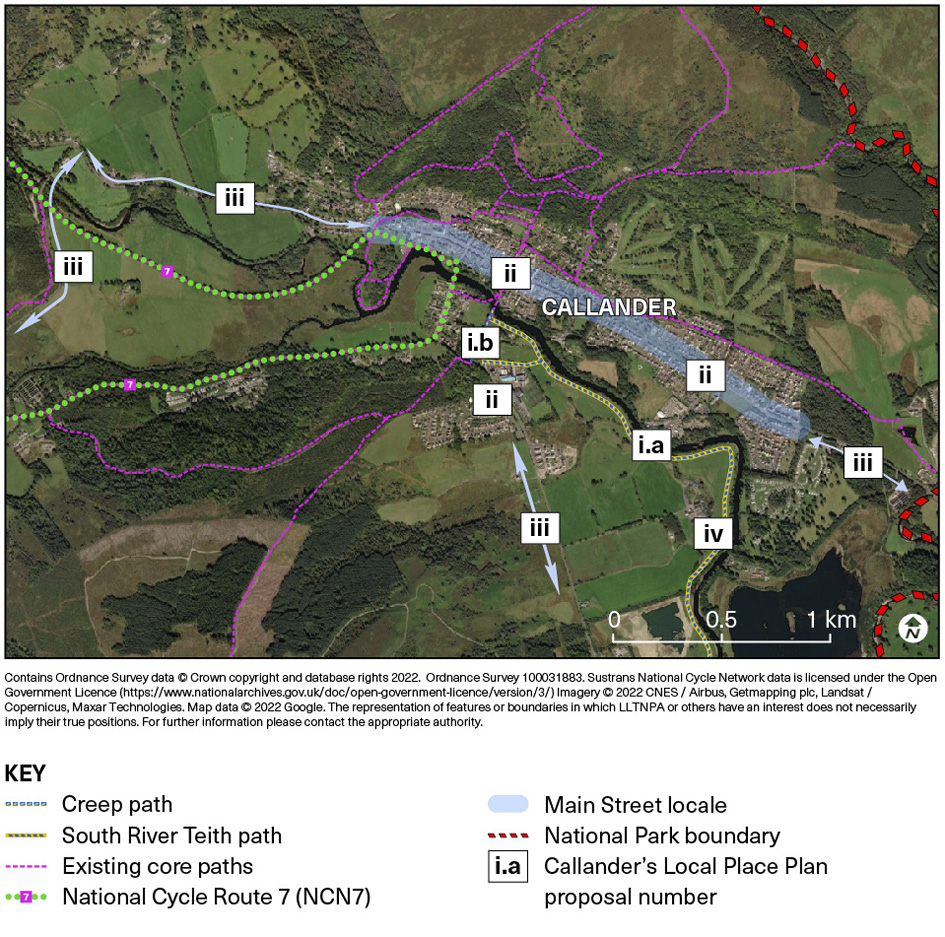Community vision – the future
Theme 1. Well connected
Even within the town, getting from our homes to essential services or workplaces is difficult without a car. Ribbon housing development along the A84 and A81 has lengthened the main part of Callander to 2.6 km from east to west on the A84, and 3 km from the east end to the newest development in the south on the A81. The High School and nursery are in the south and the medical centre and vet are in the east. Those who live at the opposite end of town to where they need to go face a 70- to 90-minute round trip by foot.
There is only one pedestrian short cut: the foot bridge across the river that joins the Creep path. The path, however, is very steep, has steps, and is inaccessible to people with mobility issues or baby buggies. Those who cannot use the Creep must negotiate the perilous, narrow pavement at the Bridgend roundabout.
Outwith the Main Street, many of our public footpaths and pavements are badly maintained. Access for people with disabilities and those with children in buggies is poor, painful and dangerous — and in places impossible — because pavement surfaces are uneven and gradients and cambers are too steep.1 Residents, especially women, feel unsafe using footpaths after dark due to inadequate lighting beyond the main drag. There is also an urgent need for safe road crossings at the east end and at the High School.
Our public transport service is not fit for purpose. Buses are cold and dirty and are cancelled without warning. The existing timetable precludes evening study at Forth Valley College for those without access to a car. An evening out in one of our nearby cities will mean an expensive cab ride home. Connections with our neighbouring communities are practically non-existent.
Poor public transport impacts on anyone without access to a car: people who need to shop locally or who need regular care at the Medical Centre; families with nursery- or primary-age children; people seeking further education or employment outwith the town; those who work in the town but live at Callander’s extremities or in another settlement. Businesses feel that an improved public transport service would help to alleviate the current labour shortage. It would also support retailers who are struggling against online competitors.
Thanks to our connections to National Cycle Network Route 7, Callander is a haven for cyclists and we certainly benefit from the trade they bring to the town. However, poor signposting means that it is difficult to find other off-road routes. At present there is no off-road path along the A81, compelling cyclists and pedestrians to share the road with fast-moving traffic.
1. In Callander some slopes at crossings far exceed the maximum gradient of 5% [1:20] considered safe for people with mobility disabilities. Furthermore, some cambers exceed the recommended maximum of 2.5% (1:40). For technical data see: i) Department of Transport (2021) Inclusive Mobility. A Guide to Best Practice on Access to Pedestrian and Transport Infrastructure. Section 4.3. Online at https://assets.publishing.service.gov.uk/government/uploads/system/uploads/attachment_data/file/1044542/inclusive-mobility-a-guide-to-best-practice-on-access-to-pedestrian-and-transport-infrastructure.pdf. ii) Kockelman, K. et al. (2002) “Sidewalk Cross-Slope Design: Analysis of Accessibility for Persons with Disabilities” in Transportation Research Record. 1818(1) 108-118. Online at https://doi.org/10.3141/1818-17 and https://www.caee.utexas.edu/prof/kockelman/public_html/TRB02Sidewalk.pdf.
Click here to return to where you were in the main text.
Solutions
i. Connecting the town
a) The construction of a pedestrian bridge over the Teith at the east end of town, along with fully accessible paths along the south of the river to the McLaren campus would allow Callander to become a 20-minute neighbourhood. Callander has been asking for a river crossing in this location since 2008 and the construction of the new primary school at the campus offers an opportunity to access the necessary funds.
b) It is unacceptable that the Creep footpath is inaccessible to wheelchairs and mobility scooters, baby buggies and cycles. It is a core footpath and, as such, should be fully accessible. It needs to be upgraded so that everyone who needs to use it can do so.
iii. Safety first
ii. There should be a formal review of all pavements and paths in Callander, leading to a plan for improvements. It should assess lighting, gradients, cambers, kerbs, and surfaces; pedestrian access and road crossings at the east end of town; and a site for a safe crossing between the Mollands estate and the High School.
iii. Community transport
Callander, Killin, Aberfoyle and Doune are investigating the feasibility of a community-run transport network connecting our settlements to one another and with Dunblane railway station.
Optimised scheduling would faciliate local commuting within the network and connection to rail services to and from Glasgow, Edinburgh, Perth and Dundee.
The envisaged low or zero carbon vehicles with bike storage facilities would also provide car-free access to the Trossachs for cyclists and tourists.
iv. Cycle paths
Existing cycle paths should be better signposted. They should be maintained and, where needed, upgraded. Better off-road connections should be created, and an off-road, all-access path should be created along the south bank of the Teith to the new cemetery, as an extension of the McLaren campus link.
Figure 3. Well connected – proposal locations

